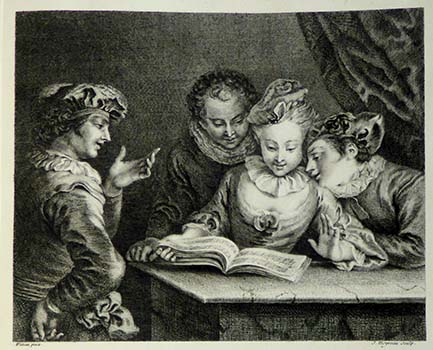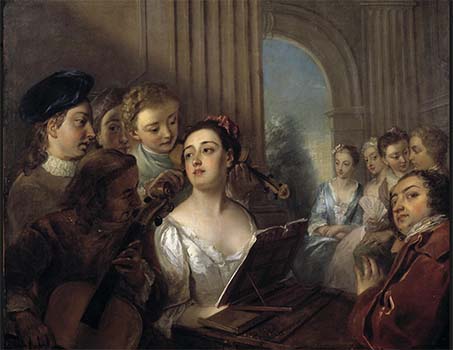
- Home Page
- Accepted
Paintings & Copies - Doubtful
Attributions - Doubtful Textual References
- Alternative
Titles - Collectors &
Museums - Bibliography
- Search Abecedario
- Watteau &
His Circle
Les Entretiens badins
Entered October 2021

Presumed lost
Materials unknown
20.4 x 24.1 cm
ALTERNATIVE TITLES
Colloqui scherzosi
Young Couple and Characters from the Commedia dell’Arte near a Statue
RELATED PRINTS
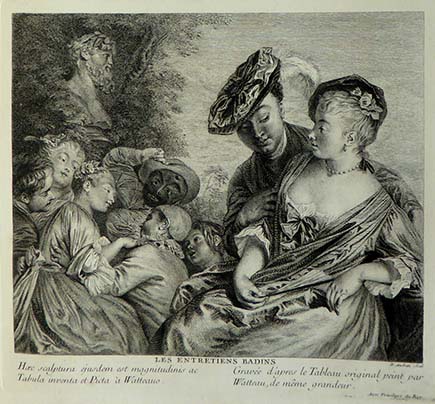
Benoît Audran after Watteau, Les Entretiens badins, engraving.
Les Entretiens badins was engraved, presumably in reverse, by Benoît Audran. The print was announced for sale in the December 1727 issue of the Mercure de France.
PROVENANCE
The painting’s provenance is unknown. Surely it was in Paris in the 1720s when it was engraved, but the name of the owner is not cited on the engraving. As far as we know, the picture did not appear in any eighteenth-century sale catalogues.
SELECT BIBLIOGRAPHY
Hédouin, “Watteau” (1845), cat. 31.
Hédouin, Mosaïque (1856), cat. 31.
Goncourt, L’Art au XVIIIème siècle (1860), 57.
Goncourt, Catalogue raisonné (1875), cat. 132
Dacier, Vuaflart, and Hérold, Jean de Jullienne et les graveurs (1921-29), cat. 95.
Reau, “Watteau” (1928), cat. 141.
Adhémar, Watteau (1950), cat. 153.
Montagni and Macchia, L’opera completa di Watteau (1959), cat. 91.
Roland Michel, Watteau (1981), cat. 123.
Roland Michel, Watteau (1984), 217.
Posner, Watteau (1984), 290 n. 53.
RELATED DRAWINGS
Les Entretiens badins is remarkable for the relatively few specific links to the artist’s drawings. Possible sources have been cited, but the suggested studies are often more generic than particular.
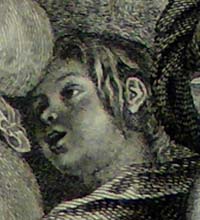
Bênoit Audran after Watteau, Les Entretiens badins (detail).
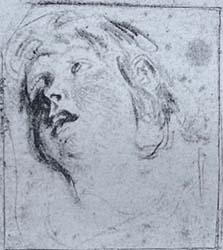
Watteau, Three Studies of a Young Boy (detail), red and black chalk counterproof. Bayonne, Musée Bonnat.
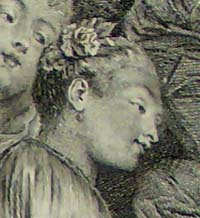
Bênoit Audran after Watteau, Les Entretiens badins (detail).
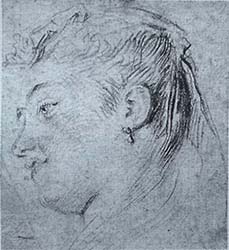
Watteau, Study of a Woman’s Head, red chalk and graphite, 73 x 67 cm. Oxford, Ashmolean Museum.
An indisputable relationship between Watteau’s drawings and painting is provided by a sheet of studies in Bayonne (Rosenberg and Prat 560). The study of a boy’s head, seen from below, was used for the child in the background of the painting. Likewise, the head of woman in a drawing in Oxford (Rosenberg and Prat 573), evidently cropped from a larger sheet of studies, was perhaps used for the woman at the left in the engraving.
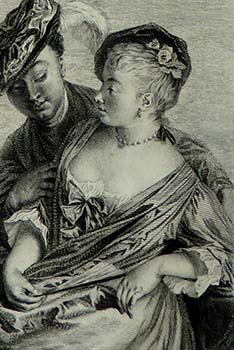
Benoît Audran after Watteau, Les Entretiens badins (detail).
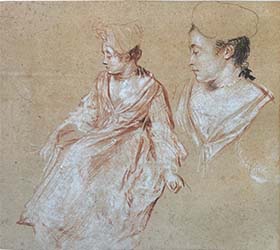
Watteau, Two Studies of a Young Woman, red and white chalk, 23.1 x 26.4 cm. Amsterdam, Rijksmuseum, Rijksprentenkabinett.
Rosenberg and Prat juxtapose the woman in Les Entretiens badins with a study in Amsterdam (Rosenberg and Prat 476), but the woman in the drawing is quite different. The only features that they have in common are the face seen in profile and the beret. However, the drawing shows a woman with a sad face, slouching body, and the beret tilted toward us. The woman in the painting is lighter, has dainty facial features, wears the beret tilted on the far side of her head, and her arms and hands positioned differently. The differences are too great to let us conclude that the one work is dependent on the other.
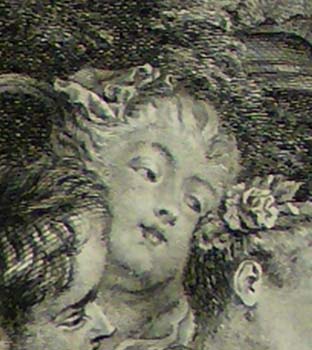
Benoît Audran after Watteau, Les Entretiens badins (detail).
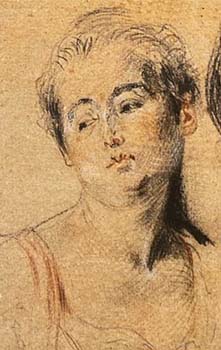
Watteau, Seven Studies of Heads (detail), red, black and white chalk. Paris, Fondation Custodia, Institut Neerlandais.
Likewise, although Rosenberg and Prat suggest a relationship between the head of a wistful woman in the Fondation Custodia (Rosenberg and Prat 557) and the head of a barely seen woman in the background of Les Entretiens badins, their sole similarity is the tilt of the head. The drawing shows a somewhat fleshy young woman, perhaps even a child, whereas the woman in the drawing is thinner and more mature.
REMARKS
In Les Entretiens badins, a group of actors and actresses enact an ambiguous narrative. Only a few of the characters, such as Harlequin, wear specifically theatrical garb. The title created for Jullienne’s Oeuvre gravé, meaning “playful banter,” suggests the spirited and carefree interchange seen here.
The format of half-length and three-quarter-length figures rarely appears in Watteau’s oeuvre. There are a few examples, such as Du Bel âge and Retour du bal; they follow a formula that was employed with regularity by European artists from the sixteenth century onward. In these works the figures are portrayed half-length, grouped together in a single, unified space. But in Les Entretiens badins the spatial arrangement is more complex: the two young lovers are compressed in the immediate foreground and loom large, while the remaining figures are set back and are smaller in scale. The effect is almost Mannerist. Watteau did not return to this idea nor did it tempt his immediate followers such as Pater and Lancret. On the other hand, Mercier experimented with such compositions, as in his Musical Concert.
Critics have paid scant attention to Les Entretiens badins, largely because it has never been seen. Roland Michel dated it to c. 1713-14; Posner posited c. 1716 -17. Most of the drawings that Rosenberg and Prat associated with the painting date between 1716 and 1718.
For copies of Les Entretiens badins CLICK HERE
